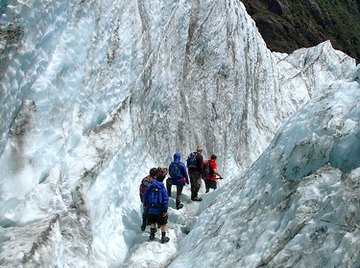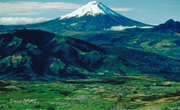
The Earth's surface continually evolves due to the shifting and shaping of its crust. Geologic features, such as fault lines, continually shift creating different mountain chains, escarpments and ridges. Specific types of fault lines, such as transform boundaries, can be found on the sea floor, in large metropolitan areas and along jagged coasts. As these shallow boundaries shift, massive earthquakes occur that forever change the landscape surrounding the transform fault.
Definition
A transform boundary is found where two continental plates slide past each other in the opposite direction, while connecting two divergent or convergent plate boundaries. The friction point between the two plates forms a transform fault boundary. In geologic study, these are distinctive from other types of faults such as the strike-slip fault. The transform fault that forms along a transform boundary is typically shallow when compared to the crust’s thickness. The shallow quality of the transform fault causes more intense earthquakes when they occur.
Locations
The most well known locations of transform boundaries are California’s San Andreas fault, New Zealand’s Alpine fault, and the Queen Charlotte fault, which affects both Canada and Alaska. All of these boundaries are considered transforming because they are formed by the slipping of two different continental plates against each other. However, most transforming boundaries are located miles below sea level, on the ocean floor.
San Andreas Fault
According the United States Geologic Service (USGS), the San Andreas fault is approximately 1,300 km in length, and at points 10 km in width. This transform boundary cuts through two-thirds of California, as the Pacific and North American plates slide against each other to form this very sensitive and active boundary.
As the Pacific plate pushes north and the North American plate pushes south, strong earthquakes occur along the San Andreas fault. In turn, these earthquakes have generated attention due to the devastation caused in heavily populated portions of California within the seismic zone.
Alpine Fault
New Zealand’s Alpine fault is located on South Island’s western coast and is part of the Marlborough Fault Zone. According to information published by the Geology Department at New Zealand’s, University of Otago, the Alpine transform boundary is unique because the Pacific plate is thrusting over the top of the Australian plate. This behavior is typically only found at convergent boundaries or subduction zones, and not at transform boundaries. As a result, New Zealand’s Southern Alps are increasing in height by approximately seven millimeters per year.
Queen Charlotte Fault
According to the Alaska Earthquake Information Center, this northern transform boundary is similar to California’s San Andreas fault and is formed from the sliding of the Pacific plate northwest against the North American plate. This transform boundary, which is part of the Queen Charlotte-Fairweather fault system, generated at least four massive earthquakes registering between 7.1 and 8.1 in magnitude. A few of these earthquakes were strong enough to be felt in Seattle, Washington.
References
About the Author
Travis Wampler began his writing career along America's forgotten highway, Route 66. His research received awards from the Association of American Geographers. Wampler has written comprehensive plans and grants for city planning departments and agencies. He holds a Bachelor of Science in geography from Southwest Missouri State University and a master's degree in information systems from the University of Phoenix.
Photo Credits
Image by Flickr.com, courtesy of Alex Proimos
